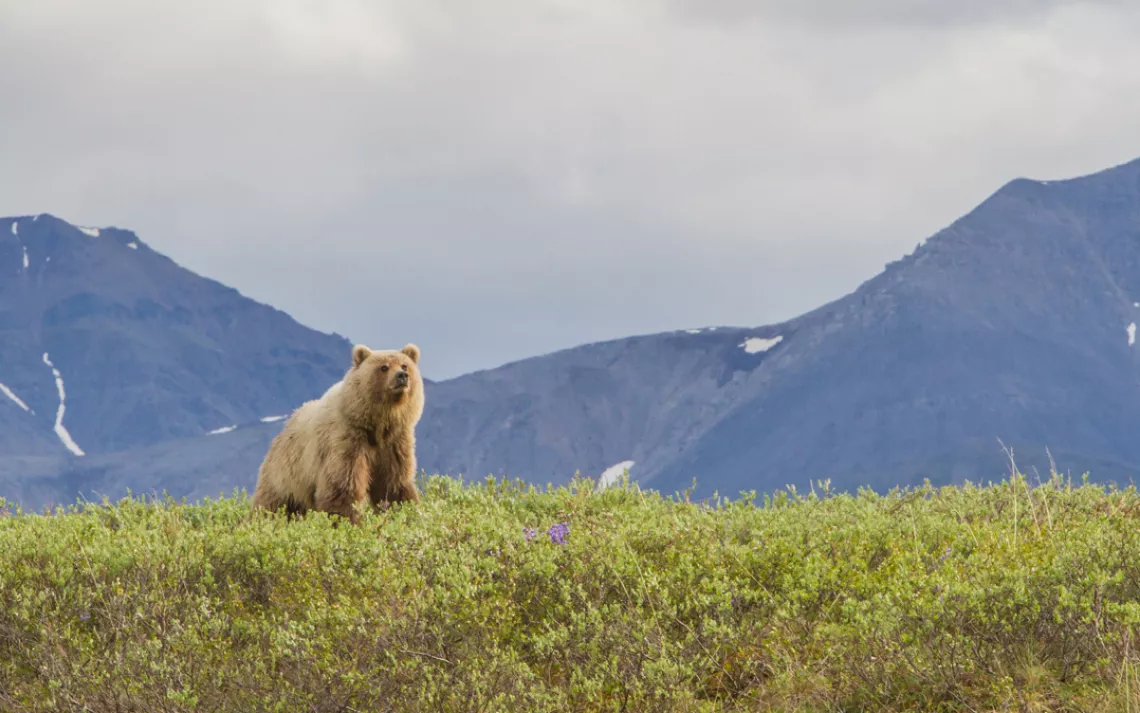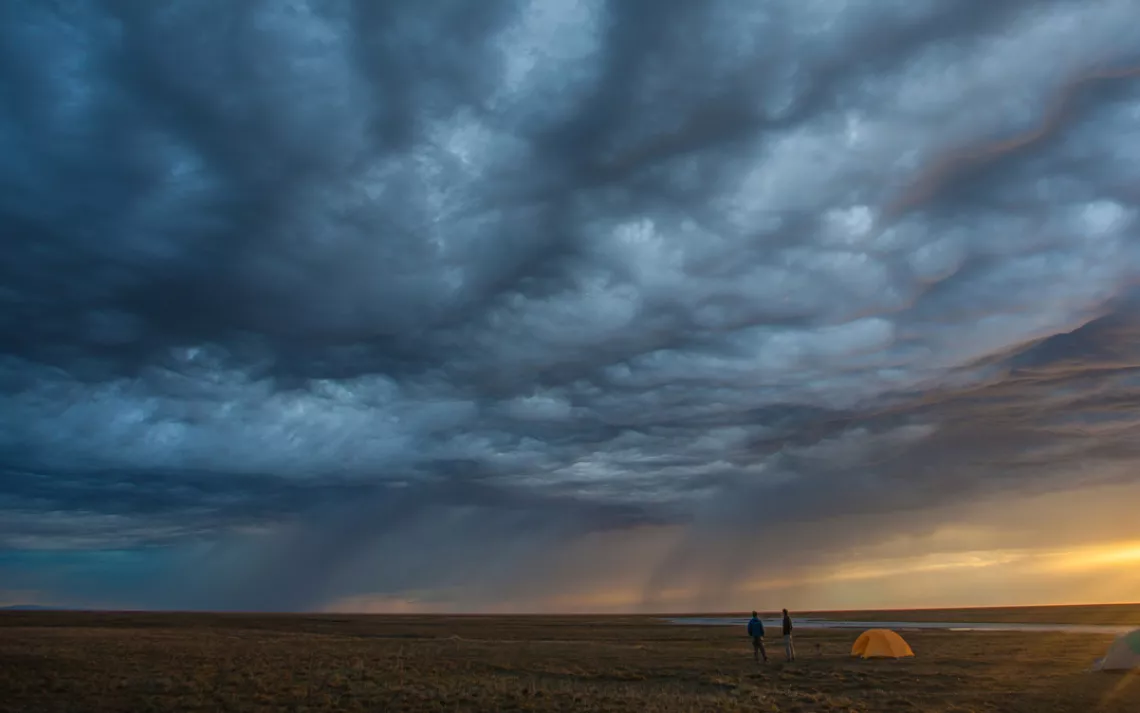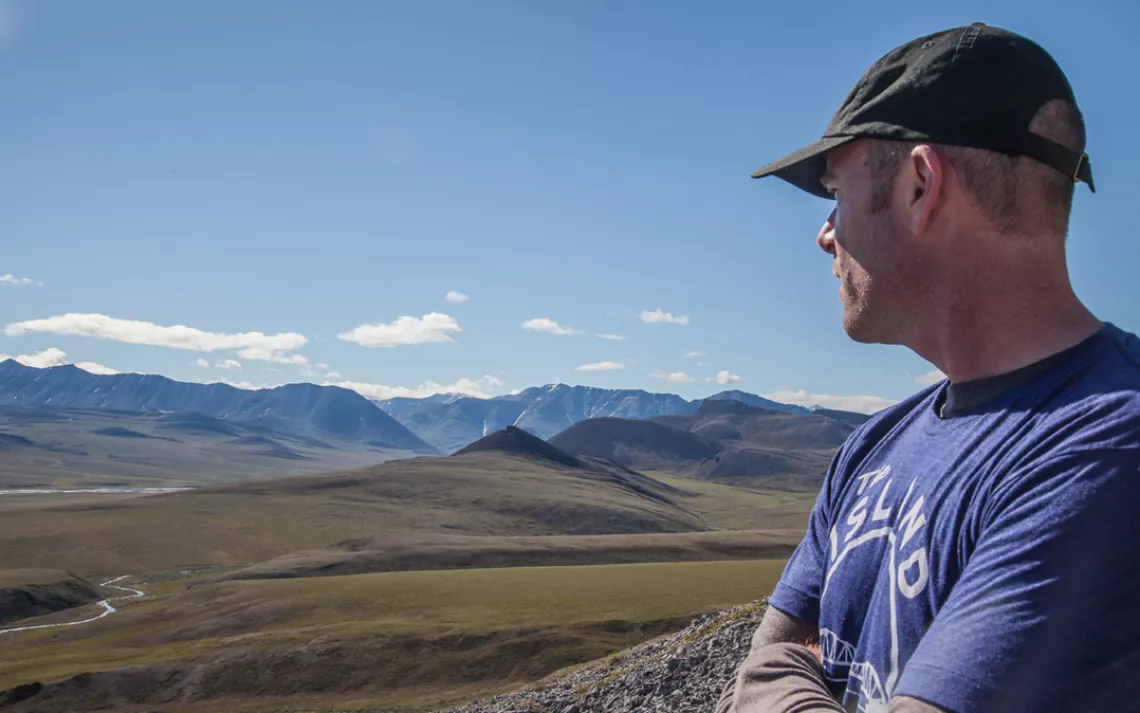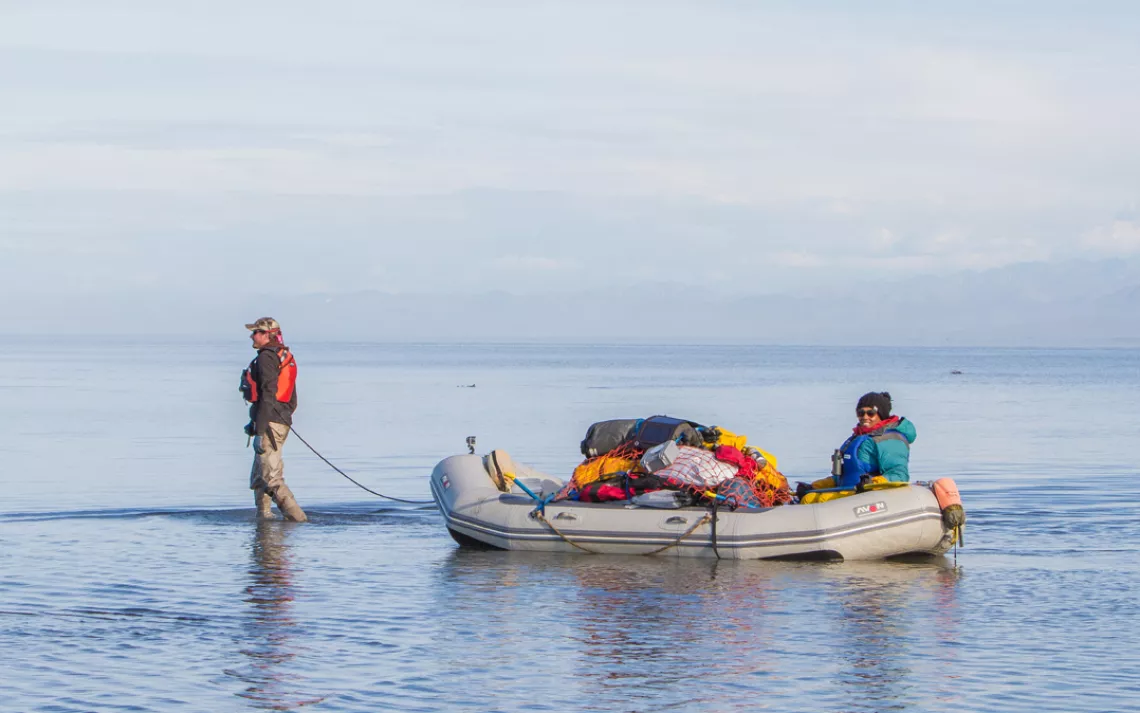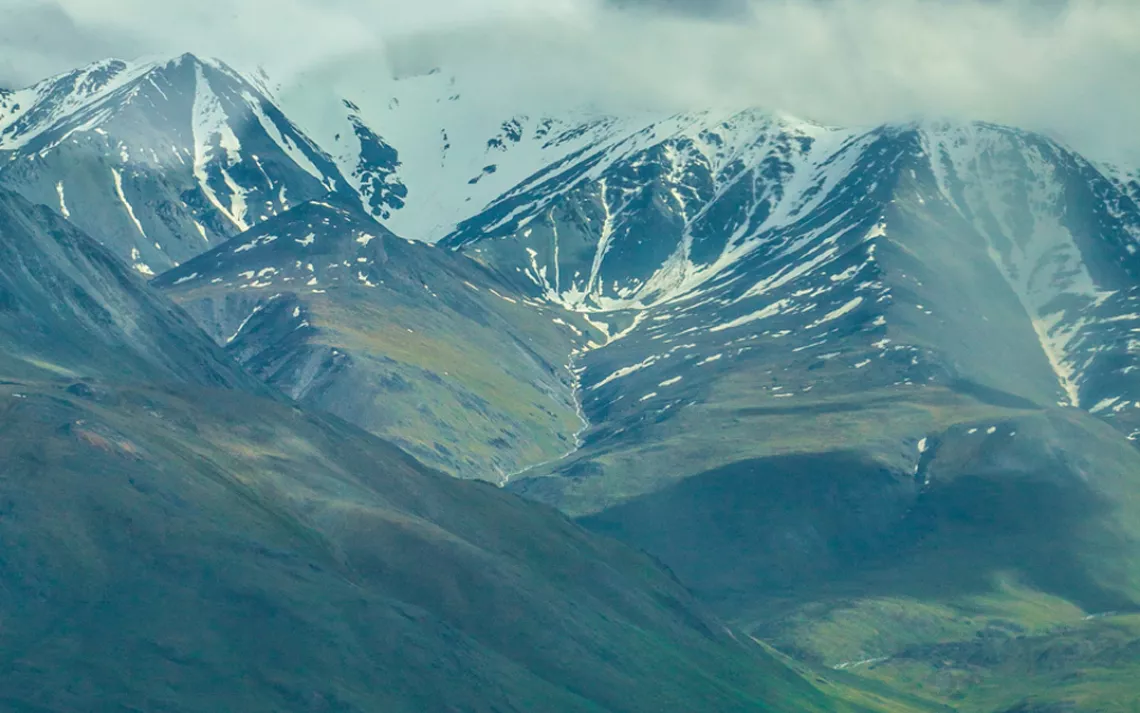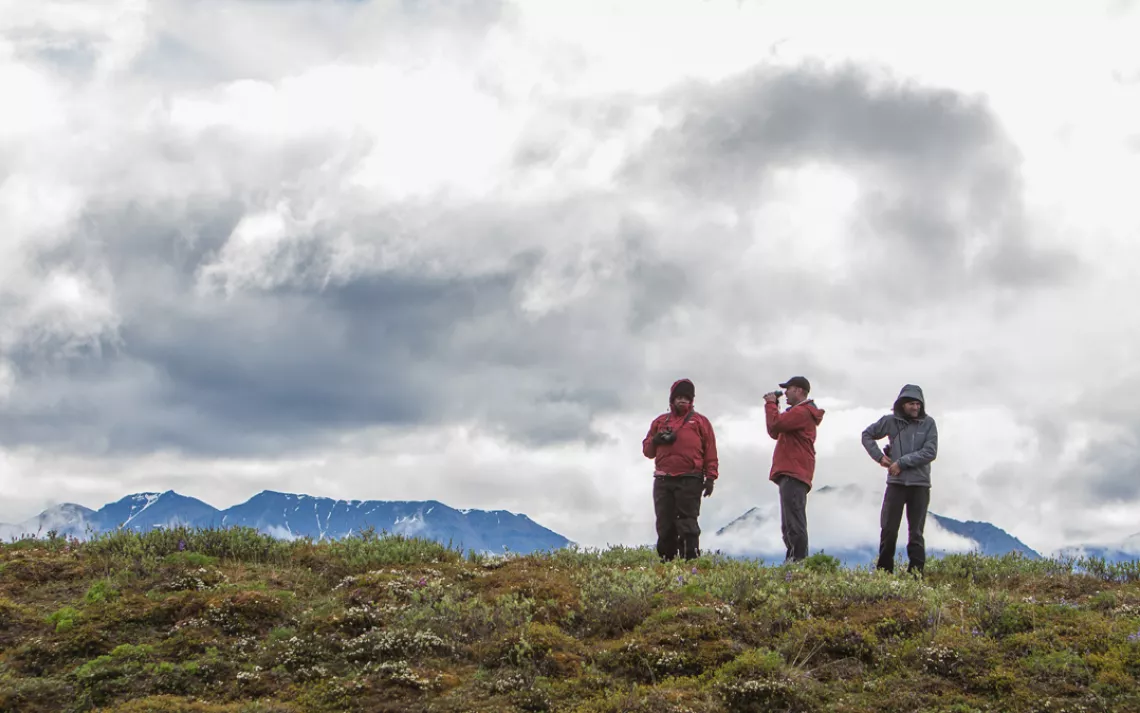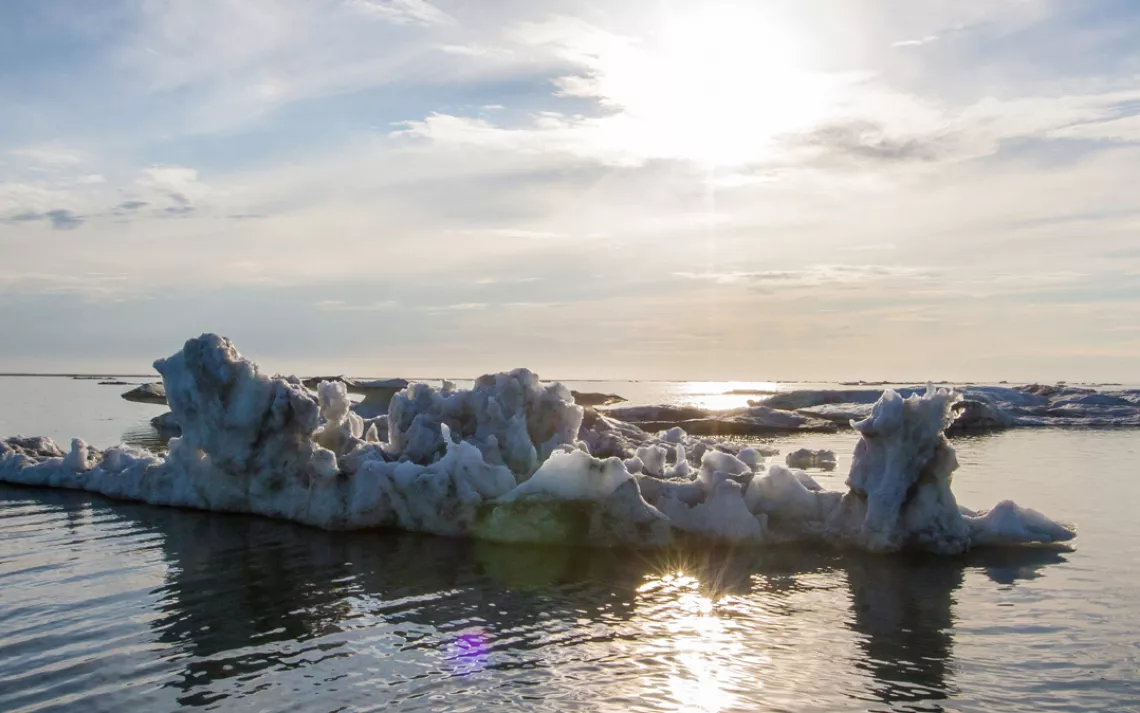Climate Change Comes to the Arctic
Alaska's Arctic refuge is already wild; it's time to declare it a wilderness.
Photographs by Micah Baird
SAFETY RULES FOR WANDERING from camp during a five-day float trip down the Aichilik River in Alaska's Arctic National Wildlife Refuge: If you go out alone, tell someone where you're headed. Always take your bear spray with you. And—this is really important—remember that bear spray only works if the bear is downwind.
Our crew of eight received this admonition from Peter Elstner, a veteran outdoorsman who would serve as our guide on a 50-mile paddle north through the great coastal plain until we hit the Beaufort Sea. We had just flown in from Arctic Village, a tiny hamlet 235 miles north of Fairbanks, in two Helio Couriers. These single-prop planes are celebrated by bush pilots for their reliability but look to the modern traveler like the VW Bugs of the sky: four seats packed into a space no bigger than a dining room table, gear roped in behind, every gauge analog.
The noise of our landing on the west bank of the river scared a small herd of caribou, which charged in front of my plane as we touched down on the tundra. While unloading, we soon noticed that caribou covered this broad valley in the foothills of the Brooks Range in numbers beyond count, dots of beige sprinkled across the green slopes.
"Whoa," said composer and multimedia artist DJ Spooky (a.k.a. Paul D. Miller). "It's so primeval." Ten minutes later, I saw him trying to approach a small clutch of caribou, walking toward them slowly and deliberately, his palms extended in a sign of peace as if they were alien beings.
We were just finishing a lunch of crackers and smoked salmon when our knowledge of those Arctic refuge safety rules was put to the test. Upriver, about a mile away on the far side, a tawny lump plodded toward us along the bank. A stiff breeze was coming through the hills, meaning that the grizzly was downwind and likely aware of our presence. It crossed the river, apparently determined to investigate the alien beings in its own realm.
Photographer Micah Baird wanted to get some shots, so he talked Dan Ritzman, director of the Sierra Club's Alaska program, into moving upstream with him. The next thing I knew, they were in full retreat, hollering and firing their bear spray. Bursts of orange mist swirled in the air—to little effect, as the grizzly continued to the edge of a small bluff no more than 20 feet from our campsite. It was a beautiful beast, its fur the color of ripening wheat, with a dark snout and dark paws and an expression reminiscent of a smart dog. It was also enormous, 300 to 400 pounds, with claws as long and as strong as knives.
We shouted. We banged pots and pans. But the bear was unimpressed. It sat down on its haunches and looked at us curiously before rolling over and scratching its back on the ground. Our yelling turned into a chorus of "awwww!" The bear popped up again and lumbered along the bluff as if planning to come down and join us. That's when Elstner broke out the 12 gauge.
Fortunately—especially considering that Sierra Club executive director Michael Brune was part of the trip—dispatching a beautiful grizzly was not necessary. The bear turned and fled as suddenly as it had approached, loping away up the hillside. After the relief came delight. Caribou by the thousands! A grizzly bear in camp! We had been in the Arctic refuge for less than an hour, and already the place had delivered.
"The Arctic National Wildlife Refuge is one of those boldface names of wilderness, up there with the Sahara or the Amazon rainforest," Brune had said the evening before we departed from Fairbanks. Each of us, however, was drawn to it for unique reasons. This was Brune's first trip to the Arctic; same for Shirley Weese Young, a board member of The Sierra Club Foundation. Saving the refuge from oil drilling has been a Club priority for a generation; their visit was in the nature of a pilgrimage.
DJ Spooky was looking for inspiration. Spooky came up in the Manhattan club scene of the late '90s, a trip-hop turntablist who was pals with the hit maker Moby. He then branched out into composing avant-garde concertos and multimedia installations, which he presented at the Metropolitan Museum of Art in New York and the Venice and Whitney Biennials. His latest passion has been global warming's impact on polar regions. One morning, we sat on the Aichilik's banks, watching water the color of chocolate milk swirl past. "It's so powerful to be here," he said, "to think about how I could write a composition, how I could make a new multimedia work, just from this openness, just from hitting the reset button on my creative process and getting away from New York and getting away from it all."
Rue Mapp, founder of an organization with the mission-explicit name of Outdoor Afro, was eager to explore new links between the racial justice and environmental movements. "I think it's interesting that the Civil Rights Act and the Wilderness Act were both passed in the same year," she had said during a welcome dinner in Fairbanks. "A big opportunity was missed then to connect the two. But we have this chance now to articulate how access to wild places is also a civil rights issue. When you're in the wilderness, it just opens up your sense of possibilities."
As for me, I'd come to the Arctic to research a book about wilderness in the 21st century. As our flight through the Brooks Range had shown, the Arctic refuge was one of those increasingly rare places where one could escape the sights and sounds of civilization. But even if a wilderness designation or national monument status could keep the oil rigs out, neither could preserve this place against the multidimensional threats of global climate change. During our trip down the Aichilik, I would come to see the hope that the refuge presents in the epoch of global warming: the possibility of a place large enough and remote enough for evolution to ride out the waves of the coming change.
OUR TRIP WAS PERFECTLY TIMED to hit the tundra's two-week-long spring, the narrow window between ice melt and the explosion of voracious mosquitoes and blackflies that make Arctic summers so miserable. Even in the week of the summer solstice, huge blocks of ice were stacked along the riverbanks, slabs of pure white and digital blue that made me think of a deep-freeze layer cake. The days were cloudless and warm, and the ice was melting fast. As we paddled downstream, our rafts zipped between colonnades of waterfalls, the meltwater torrents splashing around us.
Other than the river murmur, the scene was quiet. Sometimes we startled flocks of mergansers up out of the river, and once flushed a ptarmigan from the riverside willows. From a distance, we spotted caribou cooling themselves on far-off ice sheets. But as we traveled farther onto the coastal plain, the caribou dwindled. The land was empty and still.
Being out on the tundra felt like being on the ocean. At the top of the world at the height of the summer, the sun refused to set, and direction was all but meaningless. The never-ending light also blew apart time, turning a.m. and p.m. into abstractions. Even distance dissolved—with no trees to speak of, it was impossible to tell if something was half a mile away or three miles.
One afternoon (or was it evening?), a few of us tried to make sense of what we were experiencing. "Out here, our will doesn't mean that much," Mapp said as we set up camp. "Think of that grizzly bear—we're not at the top of the food chain. Stripping away the noise of our daily lives, we have to face ourselves and set aside our egos."
Weese Young, an avid watercolorist, found it to be "like a great painting. The space—it's so huge. It does something chemical to the brain."
One evening, I went for a solo hike on the tundra (after telling Elstner where I was going and taking my bear spray) and quickly discovered that the land was dotted with sedge- and rush-filled bogs. Elsewhere the turf was propped into fields of tussocks—foot-wide mounds rising up like mushroom caps. Barry Lopez, in his book Arctic Dreams, points out that on the tundra you're walking on top of a forest. I bent down to inspect. On each tussock there were as many as four or five species of Salix, or willow—only they were no more than two inches tall. Among them grew a universe of moss and lichen. The mosses came in a psychedelic rainbow of colors: dusky sage, forest green, glow-stick green, rust, orange, pink.
I was marveling at this elfin-scale world when I spotted a caribou half a mile away. As I reached for my binoculars, a fox darted into view, spurring the caribou to dash off. It was by far the biggest fox I had ever seen—from a distance it looked to be the size of a California coyote, cinnamon red, with a large, bushy tail tipped white. I followed it with my binoculars as it trotted through a swath of tundra where a caribou herd had passed not long ago (the ground trampled and grazed into a softer shade of green) and then went over a hill and out of sight.
When I got back to our camp, longtime Alaska hands Elstner and Ritzman were surprised by my sighting. It was unusual, they said, to see a red fox so far north, although recent studies had found that as the climate warms, the red fox's range has expanded farther and farther onto the tundra. This adaptation often comes at the expense of its smaller cousin, the arctic fox. Red foxes have been seen digging into the dens of arctic foxes to kill the kits, and sometimes even the adults. What had seemed a wonderful wildlife sighting took on a darker cast, making me think that what I had seen was something, I guess you could say, unnatural. Due to the activities of humans thousands of miles away, the arctic fox is becoming a casualty of climate change, much like the polar bear.
We'd heard similarly worrisome tales on the way into the refuge. On our flight through the Brooks Range, we had made a 24-hour stopover in Arctic Village, one of the main communities of the Gwich'in people. The Gwich'in rely on caribou for a significant part of their diet, which has made them the fiercest opponents of oil drilling in the refuge. Banners hung from the walls of the log cabin community hall where we slept: "Save Gwich'in way of life" and "Our culture is not for sale. Support wilderness."
The latter word, the elders told us over a supper of moose stew, does not exist in the Gwich'in language. So in 1988, when all the tribe's members gathered for an unprecedented summit to discuss the fate of the refuge, they took time out to come up with a way to express it. "It took them a long time," veteran tribal spokesperson Sarah James said. They finally settled on the phrase "The place where life begins."
"Leave it the way the Creator made it," James said. "That way we will know it is protected."
Today, however, because of global climate change, leaving the land alone is no longer sufficient. While average global surface temperatures rose about 1.5°F in the last 130 years, the Arctic has warmed disproportionately fast, by between 3.6°F and 7.2°F. The results are hard to miss. Migratory birds like sandpipers and phalaropes are nesting up to a week earlier. Polar bears have moved inland and mated with grizzly bears, creating a new hybrid "pizzly bear."
The Gwich'in know these changes better than anyone. "It's too warm, and it's too wet," James said. "It didn't used to rain like this in the summer. Things are changing. The knowledge that we've had for thousands of years is somehow changing. We have to relearn what's going on in order to tell our people which way is safe."
"WHAT'S THE MEANING OF wilderness in a time of great change?" Brune asked one evening on a post-supper stroll across the tundra. "I'm still trying to figure it out." The light had mellowed to the soft yellow of eternal evening. Countless white avens, buttercup anemones, and alp lilies stretched beyond sight, the whirls of wildflowers reminding me of constellations. "I know that we have to connect people to place—to encourage a love of place, or at least curiosity. Then, hopefully, they'll go do something." He paused, then said: "I don't know. It seems like we need a recalibration. We have to find a way to be comfortable with ambiguity."
On our last day, we made it to the mouth of the Aichilik. After a hard paddle across a broad lagoon, we came to a place marked as Icy Reef on the map—a long, thin stretch of sand and gravel wedged between the river mouth and the sea. The ocean was perfectly calm, the water gunmetal blue and dotted with small icebergs that had half-melted into weird, twisted shapes. Driftwood covered the strand, great piles of bone-white timber sloughed off from the forests of Canada and Alaska and washed to sea. A pair of terns guarded this strange kingdom, dive-bombing anyone who got too close to their nest.
Looking down the beach, I spotted something out of place, a bright-blue square a hundred yards away. Weese Young and I walked down the sand to inspect. It was a large plastic cooler on wheels, with a white handle for towing and "Polar Roller" emblazoned on the side. It was leaking foam insulation and was covered in pockmarks. It appeared as if a polar bear had used the Polar Roller as a chew toy.
Even the ends of the earth need a beach cleanup.
That cooler helped to clarify my thinking about wilderness. Knowing that we will inevitably mar the planet, whether with our coolers or with our climate change, makes large wilderness more important than ever. Wilderness is not about purity or primitiveness but autonomy—letting some landscapes continue to unfold without our interference, so that they might continue to be the places where life begins.
This article was funded by the Sierra Club's Our Wild America campaign.
WHAT YOU CAN DO
Last January, President Barack Obama issued an executive order directing the U.S. Fish and Wildlife Service to begin managing the entire Arctic National Wildlife Refuge as wilderness, and called on Congress to grant full and lasting protection for the area, a move that would prohibit oil drilling. "It's the biggest progress we've had in the refuge for 30 years," says Dan Ritzman, director of the Sierra Club's Alaska program.
To add your voice in support of permanent protection, visit AddUp.
 The Magazine of The Sierra Club
The Magazine of The Sierra Club
